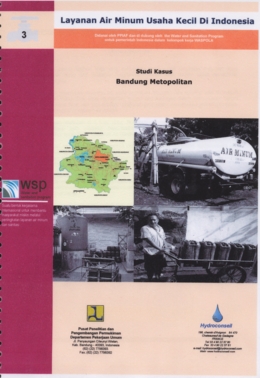Kajian

Layanan Air Minum Usaha Kecil Di Indonesia (2): Studi Kasus Palembang
09 September 2004
1.101
Daftar isi:
Kata Pengantar
Daftar isi
I. Deskripsi Wilayah Studi
II. Metoda Penelitian
III. Pelayanan Air Minum dan Sanitasi
IV. Pelayanan Air Minum Swasta
V. Peluang dan Kendala Pengembangan Usaha Layanan Air Minum Swasta
Lampiran 1 Pemetaan Harga Berdasarkan Survei Transek
Kata Pengantar
Daftar isi
I. Deskripsi Wilayah Studi
II. Metoda Penelitian
III. Pelayanan Air Minum dan Sanitasi
IV. Pelayanan Air Minum Swasta
V. Peluang dan Kendala Pengembangan Usaha Layanan Air Minum Swasta
Lampiran 1 Pemetaan Harga Berdasarkan Survei Transek

Linking Sustainability with Demand, Gender and Poverty: A Study in Community-managed Water Supply Projects in 15 Countries
Bruce Gross, Christine van Wijk, Nilanjana Mukherjee
2001
994
Daftar isi:
Foreword
Preface
Acknowledgments
Introduction
Why Gender, Poverty and Demand
Participatory Assessments
Communities and Their Services
Significant Findings
Implications for Development Practice
Towards a Framework for More Equitable and Sustained Services
Foreword
Preface
Acknowledgments
Introduction
Why Gender, Poverty and Demand
Participatory Assessments
Communities and Their Services
Significant Findings
Implications for Development Practice
Towards a Framework for More Equitable and Sustained Services

Layanan Air Minum Usaha Kecil Di Indonesia (3): Studi Kasus Bandung Metropolitan
09 Agustus 2004
1.074
Daftar isi:
Kata Pengantar
Daftar isi
I. Deskripsi Wilayah Studi
II. Metoda Penelitian
III. Pelayanan Air Minum dan Sanitasi
IV. Pelayanan Air Minum Swasta
V. Peluang dan Kendala Pengembangan Usaha Layanan Air Minum Swasta
VI. Kesimpulan dan Rekomendasi
Kata Pengantar
Daftar isi
I. Deskripsi Wilayah Studi
II. Metoda Penelitian
III. Pelayanan Air Minum dan Sanitasi
IV. Pelayanan Air Minum Swasta
V. Peluang dan Kendala Pengembangan Usaha Layanan Air Minum Swasta
VI. Kesimpulan dan Rekomendasi

Layanan Air Minum Usaha Kecil Di Indonesia (4): Studi Kasus Subang
09 Agustus 2004
1.022
Daftar isi:
Kata Pengantar
Daftar isi
I. Deskripsi Wilayah Studi
II. Metoda Penelitian
III. Pelayanan Air Minum dan Sanitasi
IV. Pelayanan Air Minum Swasta
V. Peluang dan Kendala Pengembangan Usaha Layanan Air Minum Swasta
Lampiran 1 Profil Pedagang Air
Kata Pengantar
Daftar isi
I. Deskripsi Wilayah Studi
II. Metoda Penelitian
III. Pelayanan Air Minum dan Sanitasi
IV. Pelayanan Air Minum Swasta
V. Peluang dan Kendala Pengembangan Usaha Layanan Air Minum Swasta
Lampiran 1 Profil Pedagang Air

Identifying Demand Drivers for Sanitation Technologies: The Case of Ecosan in Africa
Lukman Y. Salifu
2001
1.089
Ecological Sanitation (Ecosan) has made little progress in Africa despite decades of promotion by donors. The practical and environmental benefits of 'closing the loop' (i.e. recycling the nutriens in excreta) seem remote to most poor African households. This lack of demand for Ecosan in turn makes many sector practitioners question its potential. There are, however, a number of physical conditions - including high water table and hard rocky ground - which can increase the comparative advantage of many forms of Ecosan technology.
But beyond these physical conditions there are many factors that influence demand by households that have to be considered as well, such as the presence of small local operators involved in excreta handling.
This paper examines a number of physical and non physical demand drivers that may encourage households to adopt Ecosan solutions. It also discusses practical activities within the different segments of 'the resource loop' and a number of factors, beyond the household level, that affect the communal adoption of Ecosan and re-use of excreta.
But beyond these physical conditions there are many factors that influence demand by households that have to be considered as well, such as the presence of small local operators involved in excreta handling.
This paper examines a number of physical and non physical demand drivers that may encourage households to adopt Ecosan solutions. It also discusses practical activities within the different segments of 'the resource loop' and a number of factors, beyond the household level, that affect the communal adoption of Ecosan and re-use of excreta.

Learning What Works for Sanitation: Revisiting sanitation successes in Cambodia
2002
1.141
This report is based on site reports, photographs and participatory assessment result from communities, recorded by researchers from SAWAC (a local consulting agency) and the Ministry of Rural Development- from the central government level and the Provincial Departments of Rural Development of Kompong Spue and Battambang. The study was carried out under the overall management and supervision of the PCB project, and Leo Goulet, CTA to the Project.
Contents:
Introduction - A Quest for Understanding
1. Who has Access to Sanitation
2. What Factors Influenced Demand for Household Toilets
3. Was There a Change in Sanitation Behavior 4. What Benefits Matter Most to Users
5. Was Sanitation Coverage Linked to Hygiene Awareness and Practices
6. What Factors Influence Behavior Change
Lessons Learned
Annexure A
Contents:
Introduction - A Quest for Understanding
1. Who has Access to Sanitation
2. What Factors Influenced Demand for Household Toilets
3. Was There a Change in Sanitation Behavior 4. What Benefits Matter Most to Users
5. Was Sanitation Coverage Linked to Hygiene Awareness and Practices
6. What Factors Influence Behavior Change
Lessons Learned
Annexure A
